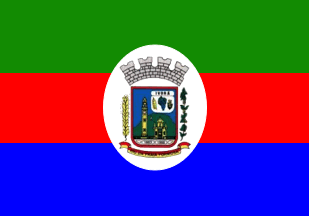 image by Ivan Sache, 19 July 2020
image by Ivan Sache, 19 July 2020 
Last modified: 2020-07-25 by ian macdonald
Keywords: rio grande do sul | ivorá |
Links: FOTW homepage |
search |
disclaimer and copyright |
write us |
mirrors
 image by Ivan Sache, 19 July 2020
image by Ivan Sache, 19 July 2020
The municipality of Ivorá (2,104 inhabitants in 2017; 12,293 ha) is located 360
km of Porto Alegre.
Ivorá was settled in 1883 by Italian immigrants
coming from Veneto and Friuli-Venezia-Giulia, as Núcleo Norte, referring to the
location of the settlement north of Colônia Silveira Martins. Valentino Zancan,
the first colonist, settled on 25 September 1883 with his wife, Osvalda Bortolot,
and their four sons Antonio, Luigi Giacobbe, Giuseppe Osvaldo and Angelo Luigi.
The urban plots were delimited in 1884. The settlement was renamed to Nova Údine
for the town of origin of several colonists. The name of Ivorá, meaning "River
of the Beautiful Beach" in Tupi-Guarani, was coined on 1 January 1939.
http://www.ivora.rs.gov.br/
Municipal website
Ivan Sache, 19 July 2020
The flag of Ivorá is horizontally divided green-red-blue, charged in the
center of the municipal coat of arms inscribed in a white disc.
Green
symbolizes the forests.
Red symbolizes the sacrifice of the Italian
immigrants.
Blue symbolizes the sky.
The coat of arms of Ivorá
features a representation of Monte Grappa and of the small chapel of the Virgin
of the Guard, representing the mountainous component of Ivorá. In the
foreground, the main church dedicated to St. Joseph, representing the people's
Christian spirit The coat of arms also features products representing
agriculture.
http://www.ivora.rs.gov.br/_arquivos/331.pdf
Municipal website
Monte Grappa is an isolated hill of 500 m in elevation, from which the territory
of seven municipalities can be watched, up to 50 km. The inhabitants of Ivorá
named it for a similar hill located in Italy, and consider it as "the symbol of
the union between Ivorá ad Italy". Old colonists built atop the hill a cave to
be used as a Marian sanctuary and as a shelter in case of destruction of their
houses by a landslide. They subsequently built a chapel dedicated to the Virgin
of the Guard, housing a statue brought from Italy in 1943.
http://www.ivora.rs.gov.br/o-municipio/turismo/pontos-turisticos
Municipal website
Photos
https://www.facebook.com/prefeituradesilveiramartinsoficial/
http://radiojornalintegracao.com.br/binotto-busca-mais-efetivo-para-brigada-militar-de-ivora/
Ivan Sache, 19 July 2020